Face Blind!
Chapter 4
The Importance of Recognizing Others
Introduction
Most people have never given any thought to how important it is to be able to recognize other people. They just take this task for granted, because for them it is automatic. If asked what it would be like to lose this skill, they might respond that it would be "lonely" or the like.
Of course, there is a reason they would feel lonely. People are driven to miss human companionship and to form all kinds of human relationships, because these were necessary for survival in a tribal society. Being unable to recognize others interferes with making and maintaining many of those relationships.
To understand what these relationships are, and how important they are to us, we need to look back to the time we lived in tribes. We evolved in that environment, and we are still tribal creatures. Civilization has only come along in the last few hundred generations, far too recent to effect significant mutational change. So civilization has not molded us to its requirements, but rather, we have molded it to fit our prehistoric tribal needs.
Our Tribal Selves - Who We Really Are
Some animals, such as bears, spend their lives mostly alone. Bears, though, are powerful animals with giant claws. A bear can take care of himself in the wild. People are relatively defenseless, and a man alone in the wild finds it tough to survive. He needs a tribe.
To function in a tribal environment, we had to learn to do certain things. As with all survival requirements, these have become drives. We are driven to do these things as surely as we are driven to eat, to mate, or to perform any other things programmed as survival needs:
- We must establish ways to communicate with each other. Communication involves two things - getting what was said and knowing which person said it.
- We must create a way in our minds to tell people apart. We must recognize individuals and remember things about each one. In effect, this means we must create a filing system with a file for each person we know.
- We have no acute sense that alone is up to this task. Dogs are social animals, but they have an acute sense of smell. A dog can smell your presence hours after you've passed by. We have no sense like that! When a dog meets you he wants a sniff. This tells him who you are, and enables him to open a file on you. Thereafter it makes it much easier for him to remember what transpires with you, because he can put it in your file. So he wants his sniff right away. Well, the most acute sense we have is vision, but with its usual processing circuitry it is not good enough to instantly tell thousands of people apart. A special part of the brain has therefore evolved to help us do that. It is its job to evaluate the face. All incoming visual face data is sent there.
And once we've developed our way of telling people apart, we are driven to create four distinct groups to help make sense of it all:
- We must recognize whether someone is friend or foe. We thus have an inborn drive to divide mankind into groups of "us" and "them," and therefore we form a concept of our "tribe". We are driven to accept as "us" those people whom we can identify easily (familiar people), those whom we can understand easily (people who speak our language), and those who share social traits such as emotional traits, personality traits, or common interests with us. Since these things are the components of "communication," it could be said that we identify with the group that we find we have the best communication with. To survive, we must be driven to be with others in our tribe. When we are among non tribe members - "the enemy" - we thus feel stress, and when we are among tribe members it melts away. If we are away from tribe members for long, we feel "loneliness," and we are driven to place ourselves among tribe members because doing that causes the feeling to dissolve.
- Tribes have social subgroups, such as "adult male hunters". It is important for survival that we be accepted as a member of our tribe, and to gain that acceptance, one must have a spot in one of the subgroups. Thus we are driven to identify a subgroup, ascertain what traits define it, and then maintain those traits in ourselves. This becomes our "core identity" a region we are driven to not drift beyond. It is usual for one's core identity to be a group within one's own tribe and sex, but one normally imposes other requirements too.
- To process how we fit into the picture, we are driven to develop a "personal identity", a concept of "me". It is a set of traits that places us somewhere within our "core identity".
- For breeding success, we must use our abilities to differentiate between people, in order to select suitable partners. We have evolved circuitry to differentiate the sex of humans, and to further evaluate individuals for suitability. People are talking about this group when they use the common expression, "He's not my type." Thus, we will refer to this group of people as one's "type". Though for most people this group is limited to one sex, there are other limits too, for example most people rule out children, and some rule out certain races. But unlike core identity and personal identity, the type group need not be limited to tribe members, and for most folks it is certainly not limited to their own sex! Genetic diversity is encouraged by extending one's type beyond the tribe, so there is no drive to maintain it there.
In summary, then, we are driven to create four groups, which I will rearrange from largest to smallest:
- tribe
- type
- core identity
- personal identity
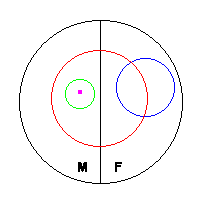 It helps to view these four groups in a diagram. In the
one to the left, the groups as they exist for a typical straight male are
shown. The large black circle represents the human race,
with a straight vertical line showing it divided into two sexes. A
red circle shows some of humanity carved out
as one's tribe. A
blue circle shows one's
type
carved out of a group of the opposite sex, some in the tribe and some
outside it. A green circle, firmly planted
within one's own sex and tribe, represents core
identity. And personal identity is
shown safely within the green core identity circle, as a pink square. This last "group" of
course only consists of one person - yourself.
It helps to view these four groups in a diagram. In the
one to the left, the groups as they exist for a typical straight male are
shown. The large black circle represents the human race,
with a straight vertical line showing it divided into two sexes. A
red circle shows some of humanity carved out
as one's tribe. A
blue circle shows one's
type
carved out of a group of the opposite sex, some in the tribe and some
outside it. A green circle, firmly planted
within one's own sex and tribe, represents core
identity. And personal identity is
shown safely within the green core identity circle, as a pink square. This last "group" of
course only consists of one person - yourself.
The reason all this is important in a study of face blindness is that the ability to construct groups of usual complexity hinges greatly on an ability to tell people apart. And this is an ability that face blind people lack to a large degree. So a face blind person may be forced to build in his mind a simpler, but more uncommon, group structure instead.
Face blind people are not the only ones to construct these groups in unusual ways. Before jumping into how this works for face blind people, it might help to look at diagrams for types of people who might be more familiar to you. You may feel some discomfort even thinking about some of these people, because people with unusual identity issues can sometimes evoke that, but it could be said that such discomfort is part of the point to be made, that face blind people can encounter difficulty from society over the way their groups are ultimately put together.
As you view these diagrams, visualize some things. Think of the problems some of these people have "fitting in", and think of how face blind people could have similar problems when they draw their circles about chunks of humanity a bit differently than most folks do:
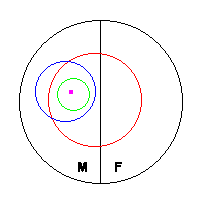 |
tribe type core identity personal identity |
Typical gay guy. |
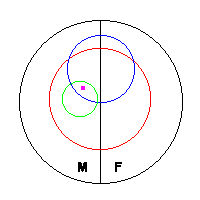 |
tribe type core identity personal identity |
Bisexual guy. |
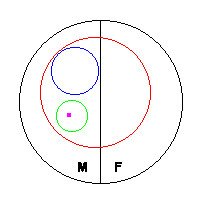 |
tribe type core identity personal identity |
A White guy who likes Asian guys but is quite happy being a White guy, himself. |
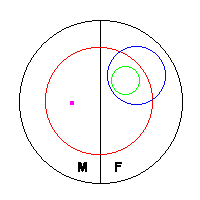 |
tribe type core identity personal identity |
A guy who likes girls and wants a sex change for himself. |
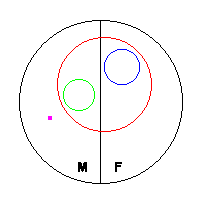 |
tribe type core identity personal identity |
An Asian straight guy who identifies with Anglo culture and wishes he were an Anglo guy. |
Now some remarks about the diagrams:
- There are no areas on the diagrams specifically designated for any groups such as Asians. Each person describes the boundaries of his circles for himself, after he draws them.
- In drawing the circles, the critical questions are:
- Which circles lie entirely within other circles?
- Which circles overlap like two "olympic rings" do?
- Which circles do not share any common ground at all?
- Where does each circle lie with respect to the vertical sex line?
- And finally the big question, which asks where one has drawn his boundaries - Which people have been placed inside each circle or circle segment?
This all seems overly complex. Yet, people do it so effortlessly, and so completely without thought, that they are not aware the process is even going on. This lack of awareness comes about because, for average people, society carves out all the groups in a way that meets their needs.
This may not be the case for a face blind person. To gain ultimate understanding of himself and how he fits into society, he may have to dig into these things. So we are bringing them up here.
That we build these categories is not what is important. What is, is what we do with them. And that is to where our discussion now shifts. Let's look at the makeup of each identity group, and how we are driven with respect to each, a bit more in detail.
Tribe
The tribe was of course originally your tribal village, but though such are today long gone, we are still trying to "find" it. We aren't equipped to handle hundreds of thousands of people, the size of a moderate-sized "village" of today, on an intimate level. So we whittle away at the multitude until we get what we feel is a workable size. This whittling process is not an easy or exact process in an intermingled town or society, but using a stereotype approach to those most distant we break off considerable chunks.
The concept of tribe is little talked about as an entity, so there is no easy word floating about to describe it. Yet, people beat around the bush in talking about it all the time. When someone refers to his " kindred spirits" or "my kind of people", he is feeling his tribe.
For many people, their tribe is something really broad, like "Chinese people in San Francisco", "white American farmbelt people", or the like. Many people so completely surround themselves by their tribe that they seldom think of other groups that exist, except perhaps to make stereotyped jokes about them. Those people have no idea of what it's like to live, in effect, among foreigners, with one's tribe fractured, and scattered in small pieces among the enemy all about him. (We will, in time, discuss how that can happen for a face blind person.)
People are mentally primed to devote much more acuity in their memory for tribe members. They identify with them in movies they see. They prefer them for lunch partners at work. And most friends are sought there. Most people get very antsy over the long haul if they are not among tribe members, because other people do not wipe away near so well the feeling called "loneliness".
As for non-tribe members, people also do not tend to "like" them as much as tribe members. They have less patience for non-tribe members, and feel they are inferior. Non-tribe members are given much less individual attention in your thoughts - treated as groups in the mind rather than as individuals, and thought of as all "looking alike".
Feelings we have for our tribes and other tribes should not be taken lightly. Humanity feels very strongly about tribes. Witness what has happened in Northern Ireland, Bosnia, and Nazi Germany....
Type
We've already said that "type" is the group of acceptable mating partners, and that it is a subset of "the sex of attraction". Unlike with tribe, not so much needs to be said, but there are a few things to be noted:- One's "type" includes the ugly as well as the cute. Put another way, an encounter with an ugly "type" person may not be pleasant but it would be doable, while with a "non-type" person it would be unthinkable.
- When one sees a person, he decides whether that person is his "type" immediately. This occurs in less than a second, as does the determination of someone's sex, and in so much the same way that it could very well be the same neural circuits that perform both tasks.
- Determination of one's "type" is much more a visual thing in some people than it is in others. Males tend to be more visually oriented in this way than are females. And visual clues play a much greater role in determining "type" than they do in determining "tribe", in most people.
Core Identity
Core identity is the corner in one's tribe that he has carved out for himself. It is a tight ring beyond which a person will not go. As with other identity categories, many people are not aware of their core identity because they've carved out a spot that society is unlikely to challenge. Its very real existence can be brought to mind by posing an example, however. All we need do is suggest you exhibit a trait that is outside your own core identity. If you are a man and your boss said starting Monday, all employees must wear high heels to work, you would probably be strongly driven to rebel. You would be witnessing your core identity at work.
Personal Identity
This is the precise spot in the sea of humanity that you've actually carved out for yourself - your "place" among all the various groups and individuals around you. One is normally content with his personal identity if it is one that makes him a unique individual but nevertheless leaves him within his core identity group and tribe.
Formation and Permanence of Identity Categories
The identity groups we have discussed are formed in early childhood. Mine were mostly in place at age nine. Gay folks often talk about the age of onset for their "type" because they are asked the question a lot. And most say, at about that age. But much of what makes up the other categories discussed here also gels at about that age.
There may be some slight movement in the limits of one's categories through the early twenties, but after that, change is very slow and quite predictable. The categories drift slightly from one decade to the next as one ages and fashions change, but they don't change much.
In Conclusion
All of the above identity categories are crucial in relating to others in society, both at work and at play. These identity categories and their associated drives hinge on recognizing and remembering people. You can imagine that someone who has difficulties with those tasks might be driven in some ways to live his life a bit differently.
Now consider that the pathways to implement this system are created when you are a young child, and the opportunities to change them lessen rapidly with each passing year. Like the ability to learn language, there is a window of opportunity during which you are driven to construct the ways you relate to others in all those ways. Later that window for the most part closes.
Now picture yourself as a face blind child. Your social setting as a young kid is limited and quite different from what you will encounter later as an adult. In that limited social environment you are driven to implement the systems described above, but the method everyone else uses to do that is closed to you. You find alternate ways. You have no idea that these ways will be with you for the rest of your life and that in choosing them you are making the most important decision in your life at an age when you are not even allowed to decide what you will have for dinner. You do it, of course, using the tools to recognize people that at that moment you have.
Thus, we next look at just how people do recognize people, and remember things about them. First we'll look at how "most people" do it, and after that, how one picks up the remnants of that system to proceed when a major tool, recognizing faces, is not available. So let us proceed to consider how most people recognize others.
![]()
"Face Blind!" - Table of Contents | |
| Chapter 1 | Introduction |
| Chapter 2 | Discovering Face Blindness |
| Chapter 3 | Physical Causes of Face Blindness - BACK |
| Chapter 4 | The Importance of Recognizing Others - YOU ARE HERE |
| Chapter 5 | How Most People Recognize Others - NEXT |
| Chapter 6 | Ways To Recognize Others Without Using the Face |
| Chapter 7 | How Non-Face Recognition Methods Work in Practice |
| Chapter 8A | ...Bill: How I Tell People Apart |
| Chapter 8B | ...Pertti: Recognition System - The Essence Model |
| Chapter 9 | Effect of Face Blindness on Emotions |
| Chapter 10 | Effect of Face Blindness on Sexuality |
| Chapter 11 | Effect of Face Blindness on Your Social Groups |
| Chapter 12 | Understanding Why People Choose To Look Alike |
| Chapter 13 | Ways To Improve Our Lives |
Appendices | |
| Appendix A | How To Find Medical Articles on Face Blindness |
| Appendix B | Getting Diagnosed (Tested) for Face Blindness |
| Appendix C | Links to Other Face Blind People |
| Appendix D | Author's Information Page |
![]()
This document is copyrighted. For information, or to contact the author, go to Appendix D, the Author's Information Page.
Text of this chapter last revised October 7, 2000.
